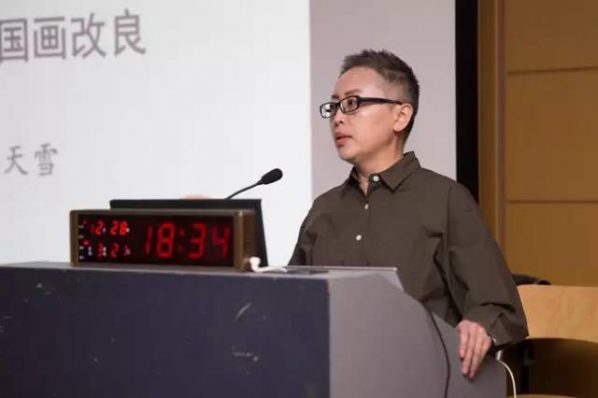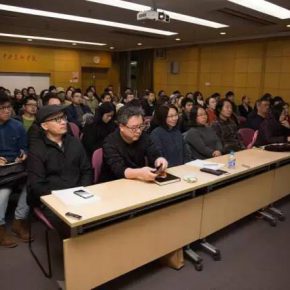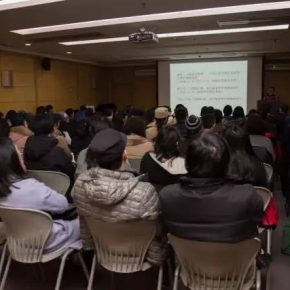
On the evening of Dec. 28, 2016, “Chang Renxia Lecture” No.5 was held in the lecture hall of the CAFA library, the guest researcher Hua Tianxue, a researcher of the Institute of Fine Arts at the China National Academy of Arts gave a lecture, and the lecture was chaired by Prof. Zheng Yan, Deputy Dean of School of Humanities, Central Academy of Fine Arts and Prof. Cao Qinghui from School of Humanities, Central Academy of Fine Arts.
Prof. Zheng Yan first introduced the origin and general information on the Chang Renxia Lecture: “Chang Renxia Lecture is the first in a series of academic lecture named after the influential senior scholar and launched by the CAFA library, initiated by Prof. Cao Qinghui and myself, organized by the library, mainly inviting outstanding scholars at home and abroad, especially young art historians to introduce their academic research results.” Then Prof. Cao Qinghui introduced the speaker: Hua Tianxue who had graduated from the Central Academy of Fine Arts with a bachelor’s and master’s degree, and had learned from Lang Shaojun in the China National Academy of Arts, who has a doctoral degree. Hua Tianxue does not fear difficulties when engaging in the study of Xu Beihong’s case and pays attention to the comparison and communication between Chinese and Western art.”
Hua Tianxue then officially started the speech. First of all, Hua introduced the origin of the lecture. Hua planed an exhibition this year entitled “Borrowing and Reform: Exploration of Chinese Painting by Overseas Students in the First Half of the 20th Century”, which opened at the He Xiangning Art Museum in Shenzhen on November 18, 2016, and launched an exhibition-related academic seminar, and Hua wrote a paper of nearly twenty thousand words for the lecture which emphasized the paper.
Hua Tianxue said: “The clues of Chinese art history in the 20th century can be demonstrated by the use of “overseas study”, starting from “overseas study in Japan” then followed by “overseas study in Europe”, “overseas study in the United States”, “overseas study in the Soviet Union”, students returned to China together with the ‘new knowledge’ in terms of technology, styles, concepts and a system, which gradually changed the ecology and pattern, from the perspective of ‘overseas study” to research the generation of modern Chinese art, and it has become one of the important topics in the field of research of Chinese art history. The improvement of Chinese painting is an unique character that makes painters who once studied abroad in Japan, different from the painters that studied in other countries. Therefore, it selected “Studied in Japan” as the research category.” Hua introduced the framework of the paper: First of all, the general situation of the artistic study in Japan; secondly, the reasons and types of “improved” Chinese painting by the painters who studied abroad in Japan; thirdly, the concrete practical experience of the improved Chinese painting by “11 painters” representing the Chinese painters who studied abroad in Japan.
Hua simply researched the basic situation of studying art in Japan: “overseas study” has always been a broad concept involving a “study tour” before 1937, and it is recognised as “Studied art in Japan.” “Studied art in Japan” started when Huang Fuzhou was admitted to the Tokyo Fine Arts School in 1905 which was a prosperous period from 1905 to 1923; when the World War I ended in 1919, work-study in the France movement was blooming, “studied art in Japan” didn’t dominate any more, but developed together with “studied art in Europe” in parallel; until the “July 7 Incident” in 1937 when “studied art in Japan” instantly stopped. From 1905 to 1937, nearly 20 art educational institutions in Japan, centered on Tokyo Fine Arts School, took in about 600 Chinese students. After returning home, they were spread over all the fields of “new fine arts” across the country, and became the major early pioneers and practitioners for changing classic Chinese art to modern art at the early stage in the 20th century.
As to the reason why Chinese painters who studied in Japan changed the traditional Chinese painting, Hua believes that there were 3 reasons, first of all, the teaching level of Western painting in Japan was not high, so the basic skills of Chinese students in Japan were generally poor, and it was difficult to be simply engaged in oil painting; secondly, it was influenced by the exploration of the “Fusion of Japan and the West”; thirdly, oversea-students in Japan were in a dark alley after returning home, for the market was still dominated by Chinese painting, so they changed to become engaged in Chinese painting. It was a quite prominent phenomenon that the painters who studied abroad in Japan changed or continued to be engaged in Chinese painting after they returned to China, in the history of the overseas study of art. This group included about 26 painters such as Huang Fuzhou, He Xiangning, Gao Jianfu, Gao Qifeng, Chen Shuren, Zheng Jin, Bao Shaoyou, Wang Yachen, Zhu Qizhan, Guan Liang, Feng Zikai, Zhang Shanzi, Zhang Daqian, Chen Zhifo, Ding Yanyong, Gao Xishun, Fang Rending, Li Xiongcai, Yang Shanshen, Huang Dufeng, Li Gemin, Xie Haiyan, Lin Naigan, Su Wonong, Fu Baoshi, Yang Taiyang. It is quite impressive. There are four types of improvement of Chinese painting influenced by Japan in the 20th century: firstly, there is Chinese Hue Art; secondly is the freehand brush work; thirdly, is the rendering of the background; fourthly is the narrative painting with figures.
This group of artists in Japan is divided into three generations by Hua Tianxue, the first generation was represented by Gao Jianfu, Gao Qifeng and Chen Shuren who went to Japan before 1910 and there are many traces of imitation; the second generation was Guan Liang, Feng Zikai, who went to Japan from 1910 to 1924, with a strong innovative style; the third generation was Fang Rending, Li Xiongcai, Fu Baoshi who went to Japan from 1924 to 1932, they were more biased towards technical quality.
Of the group of artists that studied in Japan, Hua Tianxue selected eleven painters who had representative features that improved Chinese painting, including Gao Jianfu, Gao Qifeng, Chen Shuren, Zhu Qizhan, Chen Zhifo, Guan Liang, Feng Zikai, Fang Rending, Ding Yanyong, Fu Baoshi, Li Xiongcai as the main objects of the exhibition and seminar. She briefly introduced the experiences of overseas study in Japan and the practices of improving Chinese painting through the 11 painters. Their unique improving schemes of Chinese painting are richer than the form of drawing and also retain the essential characteristics of Chinese painting, which are still references for today.
Finally, Hua Tianxue discussed the issue of “copying and borrowing”. In the process of the forming of styles of the 11 painters, the issue of “copying and borrowing” is an inevitable problem, according to the comparative study by Hua, some have corresponding work, some do not have corresponding work but it is documented and some intuitively compare it from the perspective of image. Taking the 11 painters as representatives to reflect the complex situation of the practice to improve Chinese painting which imitated Japan in the first half of the 20th century – Japanese literati painting, which is deeply rooted in the traditional Chinese painting, is a rather decorated, sweet and elegant system of Japanese painting, as well as the so-called “second-hand Western” form and so on, the multiple state of the fusion and mixed residence of the Oriental and Western painting in Japanese art world, directly resulted in diversity and complexity in the Chinese painters’ system of “copying and borrowing”, as well as the diversity and possibility of transformation, it can be said that, in the process of the forming of their styles, “copying and borrowing” is an inevitable problem, and Hua Tianxue hoped to develop a field of research in modern Chinese art history to focus on this issue.
Text by Chen Yulian, translated by Chen Peihua and edited by Sue/CAFA ART INFO
Photo by Yang Yanyuan/CAFA ART INFO


































